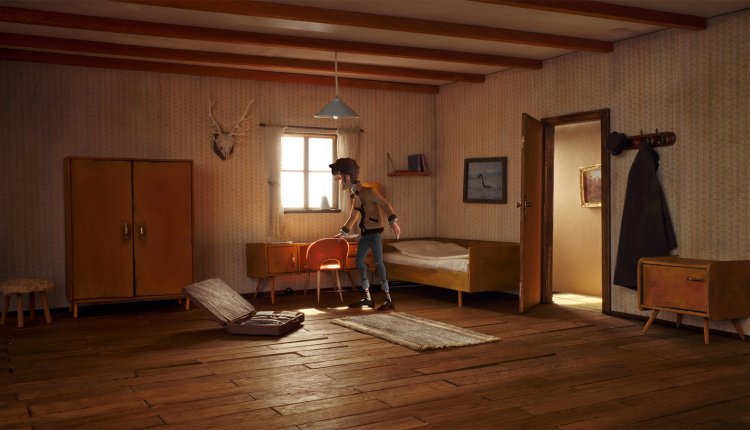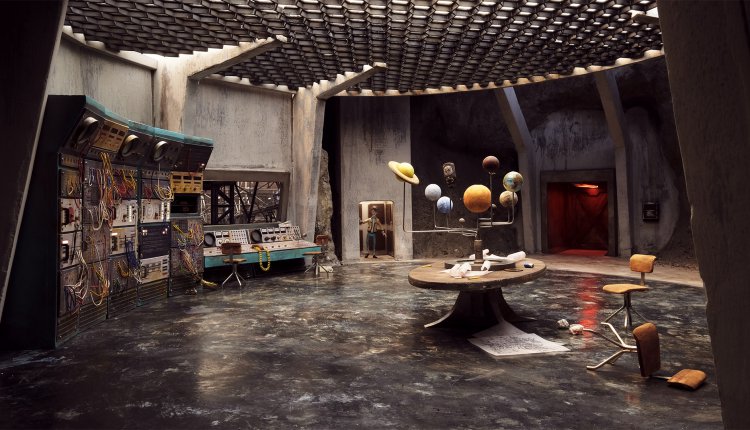Art and Soul — Trüberbrook
Trüberbrook is a gorgeous game about things not always being what they seem.
Trüberbrook is a typical point-and-click adventure game that uses technology through its story, but more importantly with the construction of its visuals. The story begins harmless enough with an American student named Hans Tannhauser vacationing to a German village. Hans’ knowledge of quantum mechanics causes him to deliver some sci-fi dialogue now and again, but the true purpose of his intellect is defined when a mystery in the hotel he is staying in sets him on a chase. Conveniently, it would take someone of sound and scientific mind to get to the bottom of it all, and he just so happens to be in the right place at the right time.
It’s all a typical setup for a game that tries desperately to be a video game version of The Twilight Zone or, more relatable these days, Twin Peaks. I don’t feel the story has the appropriate payoff nor does it really settle as something spectacular, however. Since the gameplay in these types of games almost always maintain their monotony of finding objects that move the story along, this makes the lack of impact in the story even more evident as a result. Perhaps it’s for the best that the attention to detail in the visual design is so amazingly delightful; it’ll certainly help distract you from the tropes and emotionless lines of dialogue.
I have always been enamored with the use of household items to create game worlds. Back in the eighties and nineties, there was a surge of games that used clay to create a whole manner of different genres of games; not only adventure games, but fighting games as well. I would imagine the newfound use of the process was due to the popularity of using puppetry and clay with stop-motion techniques in the visuals for children’s films at the time, such as Chicken Run and The Nightmare Before Christmas.
 During game development, by using photography instead of having to actually render the three-dimensional artwork with computer calculations, artists were able to cut corners in the technical department while still delivering impressive visuals. The movement didn’t last very long, however, as there were only a handful of games released that used the clay-based imagery; I’m sure it was likely due to the fact that claymation is a lengthy, hand-crafted process. Being a kid in that era was unique as we were all simply dumbfounded by the process and tried to duplicate the results in our own homes, using our parent’s JVC camcorders. I failed spectacularly at my budding career in claymation, but it was a fun trend while it lasted.
During game development, by using photography instead of having to actually render the three-dimensional artwork with computer calculations, artists were able to cut corners in the technical department while still delivering impressive visuals. The movement didn’t last very long, however, as there were only a handful of games released that used the clay-based imagery; I’m sure it was likely due to the fact that claymation is a lengthy, hand-crafted process. Being a kid in that era was unique as we were all simply dumbfounded by the process and tried to duplicate the results in our own homes, using our parent’s JVC camcorders. I failed spectacularly at my budding career in claymation, but it was a fun trend while it lasted.
Where Trüberbrook excels greatly is the use of photogrammetry. Photogrammetry, for those uninitiated, is the process of using hundreds or sometimes thousands of photographs to stitch together as 3D models that otherwise would be too intensive for even modern graphic engines. In Trüberbrook’s case, they used a 3D scanner to scan the real miniature scenes they made for each area in the game, which were then edited in post-process.
 This photographed process delivers such high graphical fidelity that it often looks surreal, like peeking into an alternate universe that otherwise doesn’t exist. It at times makes the game’s visuals a bit creepy but aesthetically pleasing nonetheless. When every screenshot of your game could be framed in an art museum, that’s certainly something that speaks volumes for the creation of the artwork and its process. The additional time taken has definitely paid off, as Trüberbrook is one of the most visually stunning games I’ve ever seen.
This photographed process delivers such high graphical fidelity that it often looks surreal, like peeking into an alternate universe that otherwise doesn’t exist. It at times makes the game’s visuals a bit creepy but aesthetically pleasing nonetheless. When every screenshot of your game could be framed in an art museum, that’s certainly something that speaks volumes for the creation of the artwork and its process. The additional time taken has definitely paid off, as Trüberbrook is one of the most visually stunning games I’ve ever seen.
While the main game may be lacking in substance, there’s more than enough in the graphical department to encourage a great desire to play and experience what Trüberbrook has to offer. It’s a beautiful tribute to both the point-and-click genre and game design as an art form, and I am thankful I had the chance to play it.
Trüberbrook is available now for all major platforms. Check out their website for more information about the game.
Comments are closed.